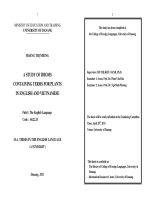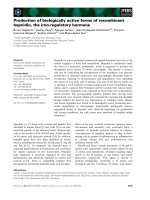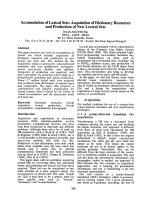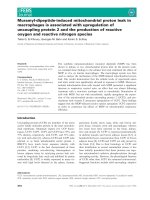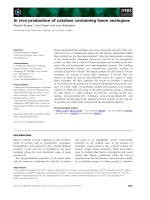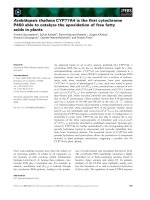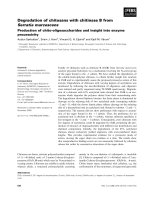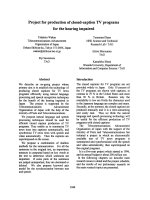Production of transgenic deepwater indica rice plants expressing a synthetic Bacillus thuringiensis cryIA(b) gene with enhanced resistance to yellow stem borer docx
Bạn đang xem bản rút gọn của tài liệu. Xem và tải ngay bản đầy đủ của tài liệu tại đây (155.13 KB, 6 trang )
Plant Science 135 (1998) 25–30
Production of transgenic deepwater indica rice plants expressing
a synthetic Bacillus thuringiensis cryIA
(
b
)
gene with enhanced
resistance to yellow stem borer
Mohammad Firoz Alam, Karabi Datta, Editha Abrigo, Alelie Vasquez,
Dharmawansa Senadhira, Swapan K. Datta *
Plant Breeding, Genetics and Biochemistry Di6ision, International Rice Research Institute, P.O. Box
933
, Manila,
1099
, Philippines
Received 14 October 1997; received in revised form 17 December 1997; accepted 23 February 1998
Abstract
Yellow stem borer has been identified as a major insect pest of deepwater rice, causing severe yield losses. Bt gene(s)
from Bacillus thuringiensis have been proven very effective in pest resistance program. The use of transgenic plants
expressing Bt gene(s) is now occupied effective approach to control insect infestation. We have successfully introduced
a synthetic cryIA
(
b
)
gene into embryogenic calli of a deepwater indica rice variety, Vaidehi, by using the biolistic
method of transformation. The presence and expression of the Bt gene in regenerated plants were confirmed by
Southern and Western blot analyses. Inheritance of the transgene was confirmed in the T
1
generation. Insect bioassays
showed an enhancement of resistance against the yellow stem borer. This is the first report of lowland rice, engineered
with Bt gene. © 1998 Elsevier Science Ireland Ltd. All rights reserved.
Keywords
:
Transgenic deepwater rice; cryIA
(
b
)
gene; Yellow stem borer resistance
1. Introduction
Deepwater rice (DWR) is grown on about 9
million hectares of flooded lands in Asia (the river
basins of Ganges– Brahmaputra of India and
Bangladesh, the Irrawaddy of Myanmar, the
Mekong of Vietnam and Cambodia, and the
Chao Phraya of Thailand) and West Africa (up-
per and middle basins of the Niger River) [1].
Farmers in these areas are very poor and follow
the traditional system of rice cultivation [2]. DWR
is grown in areas usually flooded deeper than 50
cm (sometimes up to 400 cm) for 1 month or
longer during the growing season [3]. Conse-
Abbre6iations
:
2,4-D, 2,4-Dichlorophenoxy acetic acid;
NAA, 1-h Napthalene acetic acid.
* Corresponding author. Tel.: +63 2 8450563, 8450569;
fax: + 63 2 7612406; 8450606; e-mail:
0168-9452/98/$19.00 © 1998 Elsevier Science Ireland Ltd. All rights reserved.
PII
S0168-9452(98)00053-3
M. Firoz Alam et al.
/
Plant Science
135 (1998) 25 – 30
26
quently, only traditional tall and elongating rice
cultivars can be grown in these areas. The yield of
these cultivars is generally low (1–2 t ha
−1
) and
very often, reduced further by insect attack.
Stem borers are important pests of rice because
symptoms of injury can be found from sowing to
harvest in all rice ecosystems. At the vegetative
stage, stem borer feeding inside the stem can
result in the death of the youngest leaf whorl,
causing ‘deadhearts’. During the reproductive
stage, stem borer feeding inside the panicle stalk
can lead to grain remaining unfilled, a condition
called ‘whiteheads’ [4]. Several species of stem
borer attack DWR, but the major one is undoubt-
edly the yellow stem borer (YSB). It is dominant
in the flood season, and no other species is well
adapted to aquatic conditions. It seriously dam-
ages DWR, causing yield losses estimated at 15–
20% (on the average) and reaching up to 60%
during severe outbreaks [5]. No DWR germplasm
has been found to possess acquired resistance to
YSB [6]. Additionally, no feasible biological or
cultivation method has been devised to control
this key pest in DWR field [5].
The application of insecticides to DWR possess
many problems. Ordinary ground applications are
limited to the pre –flood period and spraying is
not possible when the water is deeper than 50 cm.
Moreover, pesticides could affect beneficial natu-
ral predator and cause fish mortality [6]. Fish
harvested from DWR fields is a major source of
protein for people living in these areas. The devel-
opment of YSB-resistant varieties of DWR will
help farmers in flood-prone ecosystems
significantly.
The crystal protein or l -endotoxin from Bacil-
lus thuringiensis has been found very effective in
controlling lepidopteran insects including YSB [7].
Several crop species including rice have been
transformed with cryIA
(
b
)
/cryIAc gene from B.
thuringiensis and were shown to be very effective
against stem borers including the YSB [8– 19].
The development of transformation techniques
presented an opportunity to incorporate this
novel bacterial gene into the rice genome, which is
not possible by conventional breeding methods.
Earlier literature dealing with Bt-rice on japon-
ica [10,19] and indica [16,18] cultivars for irrigated
ecosystem are not suitable for Bt-management in
DWR. Hence, the selected transgenic Bt-rice for
deep water conditions with enhanced resistance
against yellow stem borer will provide a unique
opportunity of environmentally friendly pest con-
trol avoiding use of insecticides and other chemi-
cals in aquatic conditions. Therefore, this study
was undertaken to develop transgenic rice with
YSB resistance for deepwater rice conditions.
2. Materials and methods
2.1.
Genotype and plasmids
A popular deepwater indica rice cultivar,
Vaidehi (TCA48) of Bihar State, India, was used.
It is a traditional, tall, photoperiod-sensitive vari-
ety with a yield potential of more than3tha
−1
[20]. Plasmid pCIBBt1 (Fig. 1) carrying the syn-
thetic cryIA
(
b
)
Bt gene with the CaMV 35SP was
cotransformed with plasmid pGL2 [21] carrying
the hph gene also driven by the 35SP.
2.2.
Transformation
Embryogenic callus (EC) was induced from
scutellar tissues of mature seeds on MS medium
[22] supplemented with 2 mg 2,4-D l
−1
,30g
maltose l
−1
solidified with 8 g agar l
−1
(pH 5.8).
The EC were bombarded using the biolistic PDS-
1000/He (Bio-Rad, USA) at 1300 or 1500 psi,
following the manufacturer’s instructions and the
protocol published earlier for cereals [11,23–26].
Selection pressure was applied 16–20 h after bom-
bardment on fresh callus induction medium con-
taining 50 mg hygromycin B l
−1
as described
earlier [24]. Selection was maintained for 10–12
weeks with a change of medium every 2 weeks.
Surviving callus (embryogenic portion) was placed
Fig. 1. Physical map of plasmid pCIBBt1 carrying the syn-
thetic cryIA
(
b
)
gene driven by the CaMV35S constitutive
promoter.
M. Firoz Alam et al.
/
Plant Science
135 (1998) 25 – 30
27
on MS plant preregeneration medium containing
2 mg kinetin l
−1
, 0.1 NAA l
−1
, 30 g maltose l
−1
,
50 mg hygromycin B l
−1
and 8 g agar l
−1
,pH
5.8. Cultures were kept in the dark for 1–2 weeks.
The rest of the steps for plant regeneration of T
0
plants were carried out as described by Alam et
al. [27].
2.3.
DNA extraction and Southern blot analysis
Genomic DNA was extracted by an improved
CTAB method based on the procedure described
by Murray and Thompson [28]. Five mg/l DNA of
each sample, estimated by fluorometry and
treated with RNaseA, was digested with BamHI
and BstEII restriction endonucleases in a final
volume of 50 ml. The digested DNA was then
electrophoresed on 1% (w/v) agarose gel and
transferred to hybond N
+
nylon membrane
(Amersham, Arlington Heights, IL) according to
manufacturer’s instructions. DNA fragment of
the Bt endotoxin coding sequence from plasmid
digested with the same enzyme and labeled with
h-
32
P dCTp using the rediprime labeling kit
(Amersham Arlington Heights, IL) was used as
hybridization probe.
2.4.
Protein extraction and immunoblot analysis
About 0.5 –0.8 g fresh leaf or stem tissues of
both transgenic and nontransgenic control plants
were ground in the presence of 1.0–1.5 ml 0.05 M
Tris– HCl (pH 7.0) and 10% (v/v) glycerol mixed
with 0.1 mM phenylmethylsulphonylfluoride
(PMSF) at 4°C. Centrifugation at 13000 rpm for
10 min followed by 5 min was carried out two
times and supernatants were collected. After de-
termining the concentration of total soluble
protein using the Bicinchoninic acid (BCA)
protein assay reagent (PIERCE), each protein
extract was boiled together with sample buffer
(12.5 mM Tris pH 6.8, 20% (v/v) glycerol, 2%
(w/v) SDS, 0.001% (w/v) bromophenol blue, 2%
(v/v) or 0.3 M 2-ME) for 5 min. A total of 50 mg
soluble protein was loaded per lane in 10% (w/v)
SDS-Polyacrylamide gels. Separated polypeptides
were blotted onto nitrocellulose membrane [29] in
the semi-dry transblot SN transfer cell (Bio-Rad,
Hercules, CA, USA). After overnight blocking
with 5% (w/v) TBST-milk, Bt proteins were
probed with rabbit anti-BtK protein serum at
room temperature for 20–24 h and detected using
the procedure described by Lin et al. [30].
2.5.
Insect bioassay
Plants (T
0
and T
1
) positive in Southern or
Western blot analysis were tested for resistance
against the YSB. A single stem cutting (about 8
cm long) with at least one node (YSB prefer
nodes for sucking food) from a plant at the
booting stage was placed on a moistened filter
paper in a petri dish (100×20 mm). Six neonate
larvae of YSB (Scirpophaga incertulas) were
placed on the stem, and the petri dish was sealed
using masking tape. Incubation was performed
for 96 h at 25°C. After 96 h, the number of larvae
was determined. Similar infestation was carried
out for control plants. Each treatment was repli-
cated three times. Mortality rates were expressed
as the proportion of dead larvae to applied larvae
(%). Missing larvae were grouped within the mor-
tality category (i.e. as dead larvae).
3. Results and discussion
3.1.
Assessment of T
0
transformants
From three experiments, out of the small num-
ber of T
0
transgenic plants (30) produced, two
independently transformed lines, VA6 and VA10,
were recovered and presented in this study. South-
ern blot analysis (Fig. 2) showed both transfor-
mants had the 1.8 kb coding sequence of the
cryIA
(
b
)
gene (plasmid pCIBBt1; Fig. 1). Multiple
bands in VA6 indicated that recombination and
rearrangement of the transgene had occurred. Re-
arrangements of the transgene in T
0
transgenic
plants were also observed in different crops
[11,13,14,16,31,32]. Both higher and low molecu-
lar weight bands than the expected 1.8 kb size
were observed. On the other hand, in VA10,
several rearrangement of transforming DNA were
observed. However, both transformants were fer-
tile and produced sufficient seeds. Expression of
M. Firoz Alam et al.
/
Plant Science
135 (1998) 25 – 30
28
Fig. 2. Southern blot analysis of T
0
plants and some of
selected T
1
progeny derived from them. From banding pat-
terns two independent transformation events (VA10 and VA6)
were identified. Both events showed on 1.8 kb coding sequence
of cryIA
(
b
)
gene. Nontransformed (NT) plant showed no
bands. Except for VA10–8, all progenies showed banding
similar to that of their respective T
0
mother plants.
served in control nontransformed (NT) plants. In
addition to the expected 65 kDa band, two addi-
tional bands (between 46 and 30 kDa) were also
observed. This could be due to post-transcrip-
tional and post-translational changes of the gene.
Plants transformed with cryIA
(
b
)
/cryIAc gene
showed multiple banding patterns in Western blot
analysis [10,13,14,16]. About 0.01 –0.1% of Bt
protein was estimated in both transformants, de-
termined by comparing the intensity of the band
with known 60 kDa pure 10 ng cryIA(b) protein
(Fig. 3). Bioassay showed correlation with both
Southern and Western blot analysis. No larvae
were found alive on either transformants. Consid-
ering the bioassay data, it was clear both transfor-
mants produced a sufficient amount of Bt protein
for complete protection from YSB infestation.
Low levels of protein expression may help insects
to develop resistance against Bt toxin, which will
eventually destroy the utility of Bt transgenic
plants. In addition, proper managements will be
required to prevent the YSB to become resistant
to Bt-positive plants. Transgenic plants with high
levels of Bt-protein expression could be poten-
tially effective when grown in conjunction with
untransformed plants to serve as refuges.
3.2.
E6aluation of T
1
progeny
Bt positive T
1
progeny from both transformants
were identified by Southern or western blot analy-
ses. Results of Southern blot analyses of selected
progeny from both transformation events are
shown in Fig. 4. Except in plant (VA10-8),
progeny plants showed Southern banding patterns
similar to T
0
plants. The different banding pattern
in VA10-8 indicate that a rearrangement of the
transgene may occur in successive generations.
This may be due to deletion, addition, or translo-
cation of the transgene. However, further study
on this aspect is needed. Multiple generations and
additional progeny analysis may provide useful
information regarding such rearrangements. Goto
et al. [33] showed differences in banding patterns
among T
2
progenies of transgenic rice plants.
Nayak et al. [18] also reported different Southern
patterns among progenies of specific transforma-
tion event they analyzed.
the cryIA
(
b
)
gene in both transformants was
confirmed by Western blot analysis (Fig. 3). In
both transformants, the expected 65 kDa Bt
protein was detected. No such bands were ob-
Fig. 3. Immunoblot analysis of protein from T
0
plants (VA10
and VA6) and one T
1
progeny (VA6-4) of VA6. All three
plants show bands expressed from cryIA
(
b
)
Bt gene. Besides
the expected 65 kDa, two additional bands between 46 and 30
kDa were also observed. The amount of Bt protein (1–0.1%)
over total soluble protein was estimated by comparing the
intensity of the band with known 60 kDa pure 10 ng CryIA(b)
protein.
M. Firoz Alam et al.
/
Plant Science
135 (1998) 25 – 30
29
Fig. 4. Immunoblot analysis of protein from some selected T
1
progenies of VA10 and VA6. All progenies show banding pattern
similar to that of T
0
plants. The nontransformed (NT) control plant does not show any band.
Similarly like the case of T
0
plants, no larvae
were alive on T
1
progeny when subjected to insect
bioassays.
Transgenic DWR will help farmers in lowland
rice growing areas. Field testing of these trans-
genic lines in near future will allow the under-
standing of Bt-gene deployment in lowland rice.
This is the first report using transgenic breeding
approach for improving deepwater rice.
Acknowledgements
We thank the Rockefeller Foundation and the
BMZ/GTZ for their support. Thanks are due to
CIBA-GEIGY for providing the Bt construct
pCIBBt1. We also thank Entomology and Plant
Pathology Divsion, IRRI for helping in the insect
bioassays, Reynaldo Garcia, Jumin Tu and Nor-
man Oliva for their help in the laboratory. Drs.
Stewart C. Neal Jr. and R. Frutos for the cry
antibody. We are also grateful to Michelle Viray
for her help in preparing the manuscript.
References
[1] H.D. Catling, Rice in deepwater, International Rice Re-
search Institute, Manila, 1992, p. 7.
[2] S. Saran, K.C. John, A. Kumar, S. Ahmad, M.M. Singh,
P. Mishra, Incremental method for developing integrated
farming systems in high ecological risk zones, in: Proceed-
ings of the 1990 Asian Farming Systems Research and
Extension Symposium on Sustainable Farming Systems in
the 21
st
century, Asia. AIT, Bangkok, 1990.
[3] H.D. Catling, D.W. Puckridge, D. Hillerislambers, The
environment of Asian deepwater rice, in: Proceedings of
the 1987 International Deepwater Rice Workshop,
Bangkok, Thailand, International Rice Research Insti-
tute, Manila, Philippines, 1988, pp. 11–34.
[4] E.G. Rubia, K.L. Heong, M. Zaluchi, B. Gonzales, G.A.
Nortoin, Rice crop compensation stem borer injury, in:
Fragile Lives in Fragile Ecosystems. Proceedings of the
International Rice Research Conference, 13–17 February
1995, Manila, Philippines, 1995, pp. 817–824.
[5] H.D. Catling, Z. Islam, R. Pattrasuhi, Assessing yield
losses in deepwater rice due to yellow stem borer Scir-
pophaga incertulas (Walker) in Bangladesh and Thailand,
Crop. Prot. 6 (1987) 20–27.
[6] Z. Islam, H.D. Catling, S. Pojananuwong, Attempts to
control yellow stem borer in deepwater rice with insecti-
cides, in: Proceedings of the 1987 International Deepwa-
ter Rice Workshop. Bangkok, Thailand. International
Rice Research Institute, Manila, Philippines, 1988, pp.
551–558.
[7] H. Ho¨fte, H.R. Whiteley, Insecticidal crystal proteis of
Bacillus thuringiensis, Microbial Rev. 53 (1989) 242–255.
[8] K.A. Barton, H.R. Whiteley, N.S. Yang, Bacillus
thuringiensis l-endotoxin expressed in transgenic Nico-
tiana tabacum provides resistance to lepidopteran insects,
Plant Physiol. 85 (1987) 1103–1109.
[9] X. Delannay, B.J. LaValle, R.K. Proksch, R.L. Fuchs,
S.R. Sims, J.T. Greenplate, P.G. Marrone, R.B. Dodson,
J.J. Augustine, J.G. Layton, D.A. Fischhoff, Field perfor-
mance of transgenic tomato plants expressing the Bacillus
thuringiensis 6ar. kurstaki insect control protein, Bio/
Technology 7 (1989) 1265–1269.
[10] H. Fujimoto, K. Itoh, M. Yamamoto, J. Kyozuka, Ko.
Shimamoto, Insect resistant rice generated by introduc-
tion of a modified l -endotoxin gene of Bacillus
thuringiensis, Bio/Technology 11 (1993) 1151–1155.
M. Firoz Alam et al.
/
Plant Science
135 (1998) 25 – 30
30
[11] M.G. Koziel, G.L. Beland, C. Bowman, N.B. Carozzi, R.
Crenshaw, L. Crossland, J. Dawsonn, N. Desai, M. Hill,
S. Kadwell, K. Lauris, K. Lewis, D. Maddox, K.
McPherson, M.R. Meghji, E. Merlin, R. Rhodes, G.W.
Warren, M. Wrights, S.V. Evola, Field performance of
elite transgenic maize plants expressing an insecticidal
protein derived from Bacillus thuringiensis, Bio/Technol-
ogy 11 (1993) 194–200.
[12] F.J. Perlak, R.W. Deaton, T.A. Armstrong, R.L. Fuchs,
S.R. Sims, J.T. Greenplate, D.A. Fischhoff, Insect resis-
tant cotton plants, Bio/Technology 8 (1990) 939–943.
[13] C.N. Stewart Jr., M.J. Adang, J.N. All, H.R. Boerma, G.
Cardineau, D. Tucker, W.A. Parrott, Genetic transforma-
tion, recovery and characterization of fertile soybean
transgenic for a synthetic Bacillus thuringiensis cryIAc
gene, Plant Physiol. 112 (1996) 121–129.
[14] K. Datta, A. Vasquez, J. Tu, L. Torrizo, M.F. Alam, N.
Oliva, E. Abrigo, M. Cohen, G.S. Khush, S.K. Datta,
Constitutive and tissue-specific differential expression of
cryIA
(
b
)
gene in transgenic rice plants conferring resis-
tance to rice insect pest. Theor. Appl. Genet. (1997) in
press.
[15] M. Vaeck, A. Reynaerts, H. Ho¨ fte, S. Jansens, M. De
Beuckeleer, C. Dean, M. Zabeau, M.V. Montagu, J.
Leemans, Transgenic plants protected from insect attack,
Nature 328 (1987) 33–37.
[16] J. Wu¨nn, A. Klo¨ ti, P.K. Burkhardt, G.C. Ghosh Biswas,
K. Launis, V.A. Iglesia, I. Potrykus, Transgenic indica
rice breeding line IR58 expressing a synthetic cryIA
(
b
)
gene from Bacilllus thuringiensis provides effective insect
pest control, Bio/Technology 14 (1996) 171–176.
[17] C. Singsit, M.J. Adang, R.E. Lynch, W.F. Anderson, A.
Wang, G. Cardineau, P. Ozias-akins, Expressing of a
Bacillus thuringiensis cryIA
(
c
)
gene in transgenic peanut
plants and its efficiency against lesser corn stalk borer,
Transgenic Res. 6 (1997) 169–176.
[18] P. Nayak, D. Basu, S. Das, A. Basu, D. Ghosh, N.A.
Ramakrishna, M. Ghosh, S.K. Sen, Transgenic elite in-
dica rice plants expressing CryIAc l-endotoxin of Bacillus
thuringiensis are resistant against yellow stem borer (Scir-
pophaga incertulas), Proc. Natl. Acad. Sci. U.S.A. 94
(1997) 2111–2116.
[19] C. Wu, Y. Fan, C. Zhang, N. Oliva, S.K. Datta, Trans-
genic fertile japonica rice plants expressing a modified
cryIA
(
b
)
gene resistant to yellow stem borer. Plant Cell
Rep., 16 (1997) in press.
[20] R. Thakur, Prioritization and development of breeding
strategies for rainfed lowlands: a critical appraisal, in:
Fragile Lives in Fragile Ecosystems. Proceedings of the
International Rice Research Conference, 13–17 February
1995, Manila, Philippines, 1995, pp. 587–591.
[21] S.K. Datta, A. Peterhans, K. Datta, I. Potrykus, Geneti-
cally engineered fertile Indica-rice plants recovered from
protoplasts, Bio/Technology 8 (1990) 736–740.
[22] T. Murashige, F. Skoog, A revised medium for rapid
growth and bioassays with tobacco tissue cultures, Phys-
iol. Plant. 15 (1962) 473–497.
[23] P. Christou, T.L. Ford, M. Kofron, Production of trans-
genic rice (Oryza sati6a) plants from agronomically im-
portant indica and japonica varieties via electric discharge
particle acceleration of exogenous DNA into immature
zygotic embryos, Bio/Technology 9 (1991) 957–962.
[24] L. Li, R. Qu, A. Kochko de, C. Fauquet, R.N. Beachy,
An improved rice transformation system using the biolis-
tic method, Plant Cell Rep. 12 (1993) 250–255.
[25] V. Vasil, V. Srivastava, A.M. Castillo, M.E. Fromm, I.K.
Vasil, Rapid production of transgenic wheat plants by
direct bombardment of cultured immature embryos, Bio/
Technology 11 (1993) 1553–1558.
[26] D. Becker, R. Brettschneider, H. Lo¨ rz, Fertile transgenic
wheat from microprojectile bombardment of scuteller tis-
sue, Plant J. 5 (2) (1994) 299–307.
[27] M.F. Alam, N.P. Oliva, F.J. Zapata, S.K. Datta, Fertile
transgenic indica rice plants by PEG-mediated protoplast
transformation, J. Genet. Breed. 49 (1995) 303–308.
[28] M.G. Murray, W.F. Thompson, Rapid isolation of high
molecular weight plant DNA, Nucleic Acids Res. 8 (1980)
4321–4325.
[29] H.T. Towbin, T. Staelhelin, J. Gordon, Electrophoretic
transfers of proteins from polyacrylamide gels to nitrocel-
lulose sheets, Proc. Natl. Acad. Sci. U.S.A. 76 (1979)
4350–4354.
[30] W. Lin, C.S. Anuratha, K. Datta, I. Potrykus, S.
Muthukrishnan, S.K. Datta, Genetic engineering of rice
for resistance to sheath blight, Bio/Technology 13 (1995)
686–691.
[31] P. Christou, W.F. Swain, N.S. Yang, D.E. McCabe,
Inheritance and expression of foreign genes in transgenic
soybean plants, Proc. Natl. Acad. Sci. U.S.A. 86 (1989)
7500–7504.
[32] J. Cooley, T. Ford, P. Christou, Molecular and genetic
characterization of elite transgenic rice plants produced
by electric-discharge particle acceleration, Theor. Appl.
Genet. 90 (1995) 97–104.
[33] F. Goto, S. Toki, H. Uchimiya, Inheritance of a co-trans-
ferred foreign gene in the progenies of transgenic rice
plants, Transgenic Res. 2 (1993) 300–305.
.
